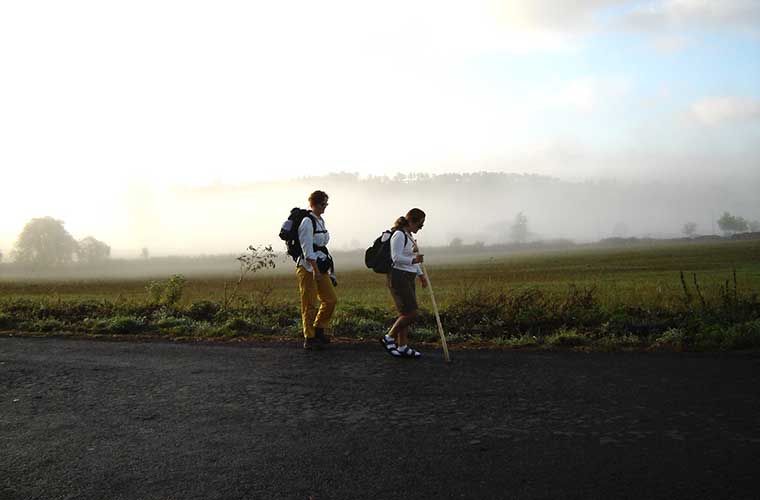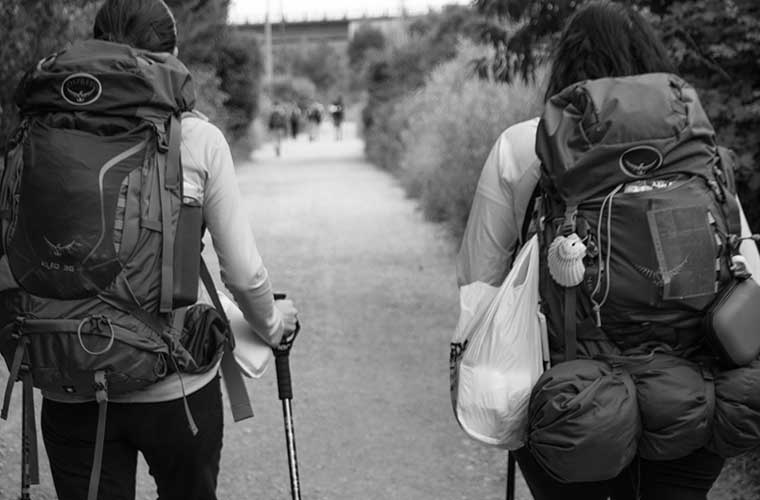What are the most common injuries and physical problems among hikers and cyclists on a stage route?

If you have done or are about to do a big stage route, as in the case of the GR11-Pyrenean Path If you are on the Camino de Santiago, it is likely that you have come across a guide of recommendations for this type of travel, however sometimes they forget to talk about something very important, the physical problems and injuries that we can find and that we will have to deal with them en route. We are going to expose you in detail, based on scientific research, what the main injuries and physical problems are you may encounter, taking as a basis the case of the The Way of St. James.
The Way of St. James
The Way of St. James is the oldest and most traditional pilgrimage in Europe, its history dates back to the 9th century, and since then it has been followed by different routes, both on foot and in more recent times by bicycle and on horseback.
It was considered the First European Cultural Itinerary, and although religious motivation was originally the main factor, nowadays it is also travelled for tourist, recreational, sporting, convivial or leisure purposes.
In 2006, researchers from the University of Almeria and the University of Granada, led an unpublished study to try to know in greater detail the type of physical affectations that pilgrims suffered on their route to the Cathedral of Santiago de Compostela.The study was carried out by applying a questionnaire to more than 1,000 subjects who successfully completed the journey.
The sample considered allowed us to generate a reliability index of +-95% in the results, from which we obtained interesting results that allow us to elucidate the most frequent affections, which vary according to the place of origin, but even more so according to the means of transport.

Main risks for hikers
One of the most compelling findings was the fact that the blisters represented by far the most recurrent affectation suffered by those who choose to walk the Camino a Santiago, specifically, more than 61% of walkers.
No other ailment is as common among pilgrims as blisters, so if you are considering such a trip, it would also be a good idea to take precautions against blisters. key recommendations to minimise the possibility of blisteringThis means covering your feet with tape or some kind of adhesive tape to reduce the impact of constant friction on the skin, as other research has concluded.
Secondly, we have the tendonitisThis condition, suffered by almost 40% of those who walk the Camino a Santiago, is essentially an inflammation of the tissues that connect the muscle to the bone.
This type of ailment is common in athletes, such as those who play tennis or golf, and is caused by high daily physical exertion.
Another recurrent affection in the walkers of the Camino a Santiago, is the foot sores, painful condition that affects almost 1 in 5 pilgrims.
It should be noted that the same study also analysed the differences between Spanish pilgrims and those from other European countries, as well as those from the rest of the world. In all cases, blisters and sores are recurrent in pedestrians, although an even higher incidence was detected in those from other European countries.
The researchers alluded that these differences would be motivated by the average distance travelled, because while in Spain, there are several departure points closer to Compostela, at a European level the average distance travelled is greater.
Other less common conditions, but also present in pilgrims on foot, are colds and sunstroke, which affect just over 10% of travellers, and slightly fewer are also affected by blows and falls; although all of these are actually conditions that are more present in cycle tourists as we will see below.
Main risks for cycle tourists
For example, blisters and sores, although also present, actually only affect less than 10%, due to the fact that there is less friction on the skin, which reduces the risk of this type of ailment.
On the other hand, the bumps and falls are listed as the most common affliction in cycle pilgrims, almost 1 in 3 acknowledged having suffered such an incident during the journey, which can also cause the most serious damage.
Cyclotourists are also affected by tendinitis, although at about half the rate of walkers, i.e. just over 20% of cases.
Cyclists, however, also seem to be more affected by other types of ailments such as colds and sunstroke, This is a problem that appears in almost 1 in 5 cases, which represents an incidence of almost double compared to hikers.
The experts concluded that this is mainly due to the fact that they travel longer distances and therefore also have longer cooling periods and temperature changes, as well as the fact that they tend to extend their daily commute for longer periods of time. The research also cites data from other studies which show that this type of problem is also accentuated when the daily commute ends in the late afternoon.
Final recommendations
As you can see, there are several main affectations that you can suffer if you do the Camino a Santiago, or any other excursion, and it is best to take the necessary precautions to reduce the risks as much as possible.
The use of tapes to prevent blistering, the wear comfortable, well-fitting footwear to reduce the risk of sores, a sufficient hydration and try to wear sunscreen and some kind of hat to reduce the risk of sunstroke, are some important recommendations.
Similarly, if you are going to make the journey by bicycle, it is important to make sure it is in good condition, avoid speeding and take special care on slopes and winding roads, these are some of the recommendations for a successful journey.
However, consideration should also be given to other possible risks, such as the migraines, allergies, gastroenteritis, chafing and muscular problemsThe good preparationThe use of water, sufficient food and water, as well as taking things slowly and at your own pace, will also be of great help to successfully complete this millenary journey.
Scientific article:Granero Gallegos, A.; Ruiz Juan, F. and García Montes, M. E. (2006) Injuries and physical problems suffered by walkers and cycle tourists on a route in stages. The case of the Camino de Santiago. International Journal of Medicine and Physical Activity and Sport Sciences vol. 6(22) pp. 99-109. http://cdeporte.rediris.es/revista/revista22/artlesiones31.htm
READ ALSO:
Don't miss any adventure in the Pyrenees!
